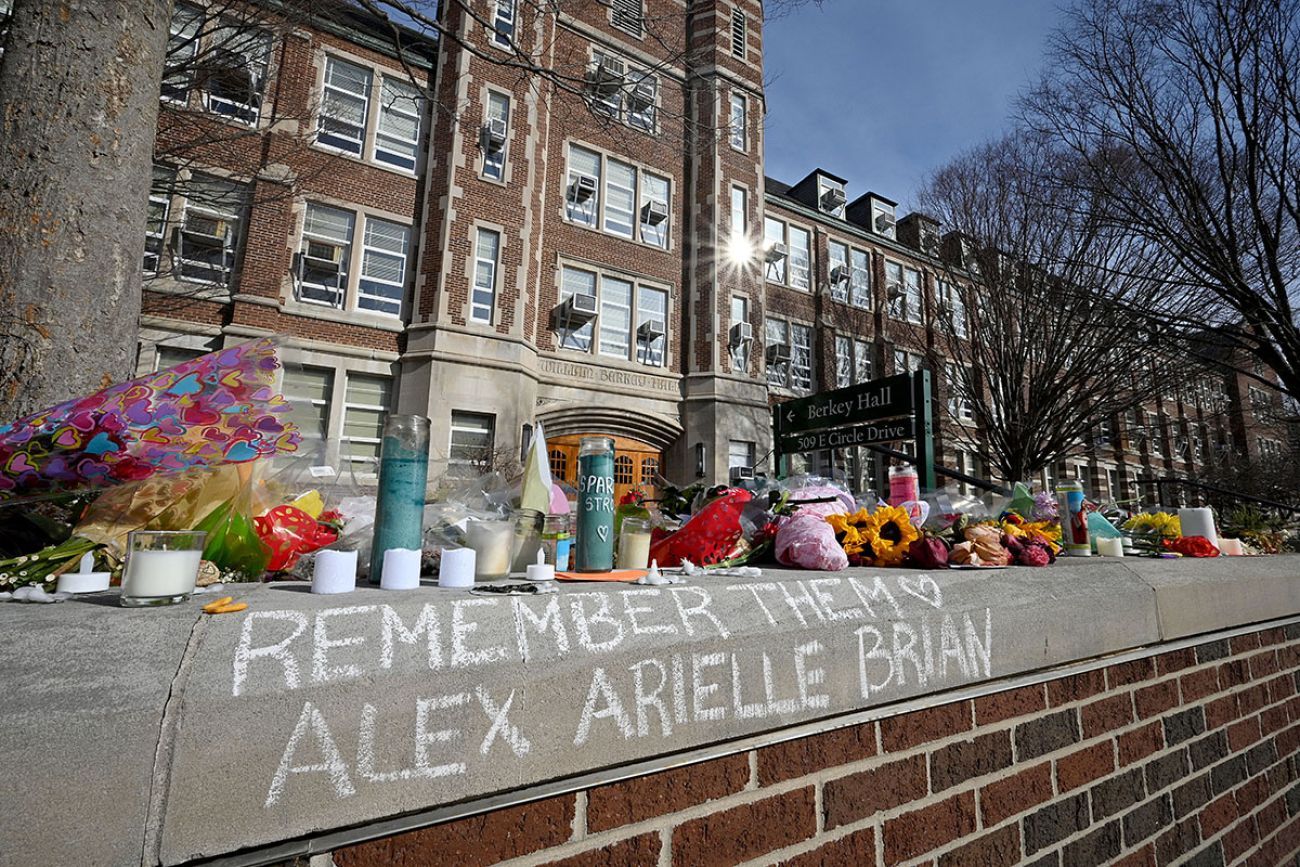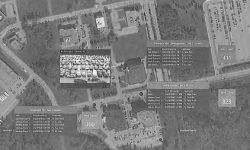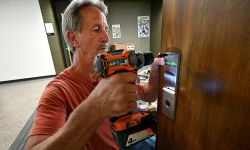Outside report says MSU should improve security following deadly shootings


- Michigan State should make it easier for all dispatchers and more officers to initiate a campus lock-down, an outside consulting firm has told the university
- The response to the Feb. 13 shooting by university officers was “appropriate, timely and correct,” according to the report
- The report also calls for improved classroom locks and more and better video surveillance capabilities
An outside public safety consulting firm report Tuesday concluded that Michigan State University police emergency response to a deadly campus shooting Feb. 13 was “appropriate” and did not contribute to the loss of life that evening.
The consultant suggested, however, that the university itself should take steps to improve security, including improving classroom locks, updating video surveillance capabilities and making it easier for emergency staff to lock-down campus following the shooting, which left three students dead and five others seriously wounded.
The “after-action” report by Security Risk Management Consultants also found that some members of the MSU Board of Trustees “became more involved in the incident beyond the customary role” and suggested they undergo training on what their roles are during emergencies and disasters. No details were provided.
Related:
- Michigan State University cancels classes on anniversary of shooting
- Lawyers for 3 more students indicate they may sue MSU in shooting
- Michigan State University expands ability to issue emergency alerts
The report MSU released is summary in nature, and contains almost no narrative detailing interviews with campus officials.
The report concludes the emergency response by university police officers was “appropriate, timely and correct” and said it “in no way contributed to the prolongation of the incident, nor did it contribute in any way to additional loss of life.”
“This report is a critical next step in our ongoing commitment to ensuring MSU is a safe place for all who come to our campus,” said MSU interim President Teresa Woodruff in a statement. “It provides concrete recommendations for strengthening campus safety and reinforces our efforts are on the right track.”
However, the report by the Ohio-based consulting firm does not address the apparent gap between the initial 911 calls about an active shooter, which came in at 8:18 that Monday evening, and 8:30, when the first campus-wide notifications went out.
And it does not address why it took 10 minutes to issue that notice after a sergeant on the scene called for a campus-wide lockdown.
Michigan State officials acknowledged that so many officers went to the scene that no one was at headquarters who could log into the system that sends emergency alerts.
The report appears to reference that problem by calling upon Michigan State to greatly expand who can initiate a campus lockdown. The report calls for all dispatchers to have access to an emergency lockdown button and appears to suggest the process on Feb. 13 took too long.
“The process should include a verbal authorization process using radio communication so the lockdown can be initiated from the field,” the report states.
The report acknowledged that Michigan State has already limited hours campus buildings are open to the public, installed 65 percent of classrooms with new locks and added additional cameras to academic buildings.
The report, however, said the university has changed plans for active violent intruder training for all students and staff. In the wake of the shooting, it was going to be mandatory but is now “strongly recommended and encouraged,” according to the report.
Just after 8:15 on Feb. 13, Anthony McRae, 43 of Lansing, entered a classroom in Berkey Hall just off Grand River and began shooting, killing two students and seriously injuring several others. He then went to the student union and resumed his attack, killing a third student.
McRae shot and killed Alexandria Verner, 20, of Clawson, and Arielle Diamond Anderson, 19, of Harper Woods, in the Berkey classroom before killing Brian Fraser, 20, of Grosse Pointe Park at the MSU Union.
The five students who were critically wounded were also believed to be shot in Berkey Hall, although police have never confirmed that detail.
It took several hours before area police were able to locate and confront McRae a few miles from campus. Police say the gunman killed himself as they approached. He was pronounced dead at the scene.
In the aftermath of the shooting, students expressed frustration with the university’s messaging alerts, with two identical messages at 8:30 and 8:31 and then none until 10 p.m. Meanwhile, officers were criss-crossing campus looking for McRae and investigating dozens of reports of additional shootings and suspicious people and cars.
The report offered a number of recommendations, including:
- Improving security technology, including video cameras, and considering the use of artificial intelligence to help monitor the video feeds for things like suspicious bags.
- Adding a feature “immediately” that would make it possible to lockdown campus from the campus dispatch center and at the police department “for any officer to initiate.”
- Providing more emergency messages during the “the extended time the campus was in a ‘lockdown’ condition.”
Lawyers for seven of the eight students killed or injured filed papers indicating they were contemplating litigation against the university, arguing that MSU was negligent in failing to adequately safeguard the campus from a potential shooting and by its actions, or inactions, as the attack unfolded.
In one notice to sue, filed with the Michigan Court of Claims in June, an attorney for Yukai “John” Hao claimed the university and its departments “acted with gross negligence and failed to take reasonable steps to protect students and visitors on its campus from harm.”
The attorney, William Azkoul, cited how the university allowed public access to buildings in the evening, did not employ security guards to monitor building access, failed to install locks on the inside of classroom doors and failed to use lock systems that allowed instructors to activate locks.
In its report, SRMC acknowledged that Michigan State added dead-bolt “thumb-turn” locks to 65 percent of classrooms. But it called for different locks that would prevent them from being left unlocked. And it called for magnetic door holders connected to a system that would allow for an automatic lockdown from the dispatch center or the police department.
It also called for improved video surveillance capability. A Bridge Michigan report revealed how many public safety officers at many campuses — but not Michigan State — have the ability to monitor hallways and outdoor areas 24 hours a day from a central location.
See what new members are saying about why they donated to Bridge Michigan:
- “In order for this information to be accurate and unbiased it must be underwritten by its readers, not by special interests.” - Larry S.
- “Not many other media sources report on the topics Bridge does.” - Susan B.
- “Your journalism is outstanding and rare these days.” - Mark S.
If you want to ensure the future of nonpartisan, nonprofit Michigan journalism, please become a member today. You, too, will be asked why you donated and maybe we'll feature your quote next time!


